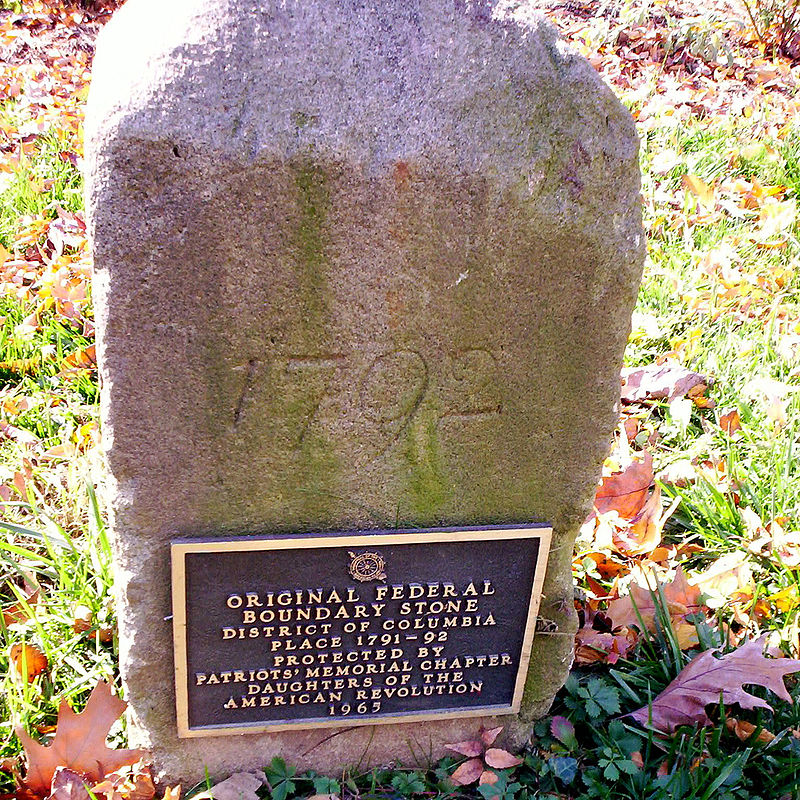

In 1915 the District of Columbia Chapters adopted the Boundary Stones, acquired deeds from the property owners to install a footing for the iron protective fences." They had identical fences designed and installed and finally in 1916/1917 dedication ceremonies took place to mark each stone with a plaque with the name of the Chapter who agreed to be its steward. It is a flat piece of stone embedded within brickwork and. Acting on instructions from Secretary of State Thomas Jefferson, Major Andrew Ellicott began surveying the ten-mile square on February 12, 1791. Wall stones this type of stone illustration 2 marks the end of a boundary line as it meets a wall. President Washington selected the southernmost location within these limits, so that the capital would include all of present-day Old Town Alexandria, then one of the four busiest ports in the country. The Residence Act of July 16, 1790, as amended March 3, 1791, authorized President George Washington to select a 100-square-mile site for the national capital on the Potomac River between Alexandria, Virginia, and Williamsport, Maryland. Nauders is located in the border triangle Austria-Switzerland-Italy: This hiking tour leads us past the Black Lake and the Green Lake to the Boundary Stone.

The new boundary incorporated a larger area into the city, including the Aventine Hill and the Campus Martius, but Claudius’ primary motivation is evident from the inscription, which states that he ‘extended and redefined the pomerium because he had increased the boundaries of the Roman people’, revealing that this act was less about the expansion of the city of Rome itself than it was a political statement celebrating Claudius’ expansion of the wider Roman Empire, including his conquest of Britain in AD 43.Ĭlaudio Parisi Presicce, director of the Archaeological Museums of Rome, described the stone as ‘an extra piece of the jigsaw for the understanding of ancient Roman society’."The boundary stones are the oldest federal monuments.

The travertine stone, which measures 193cm by 74.5cm by 54cm, bears an inscription detailing Claudius’ titles and honours, and his decision to expand the pomerium. It is believed that Claudius laid more than 140 of these cippi around Rome, but only 11 have been found so far, and the last discovery occurred more than a century ago, in 1909, making this latest find particularly significant. The recently discovered stone was laid in AD 49, when the boundaries of the pomerium were expanded by Emperor Claudius, who ruled between AD 41 and AD 54. Boundary Stone: A New Pub in Bloomingdale You'll find 64 whiskeys and 16 tequilas at Boundary Stone Photograph by Kyle Gustafson Boundary Stone: Bloomingdale's New Pub The eight beer taps will rotate seasonally Photograph by Kyle Gustafson Boundary Stone: Bloomingdale's New Pub The pressed tin ceiling was part of the original Sylvan Theater. quinoa & garbanzo patty, lettuce, cucumber, pickled red onion, basil & tarragon mayo. Seven Hills Farms patty and your choice of fixins. He spent most of his life in Baltimore County, Maryland. Seven Hills Farm patty, bacon jam, bleu cheese, sauted onions, pickled beet. The east side of the stone bears the engraving, 'Virginia' and the north side, '1791, the year Banneker helped survey the city. Its extent was marked by large cippi (border stones). The SW-9 Intermediate Boundary Stone of the District of Columbia, located in Arlington, Virginia, is still in place. The pomerium was a consecrated boundary area within which it was forbidden to farm, build, or carry weapons. This standard has been transformed into HTML and then translated into a number of languages. Description: Abstract: DC Boundary stone locations. It is now on temporary display in the Ara Pacis Museum fittingly, next to a statue of the Emperor Claudius and will eventually be displayed at the Mausoleum of Augustus. Title of Legally Binding Document: Type Designs for Boundary Stones LEGALLY BINDING DOCUMENT Step Out From the Old to the New-Jawaharlal Nehru Invent a new India using knowledge.-Satyanarayan Gangaram Pitroda. Title: Boundary Stones Location Geospatial Data Presentation Form: vector digital data. This 2,000-year-old stone, which once marked the pomerium, the sacred boundary of the ancient city of Rome, was discovered during excavations in the Piazza Augusto Imperatore.


 0 kommentar(er)
0 kommentar(er)
